ISLAM
Internal warfare left the sub-continent vulnerable to attack, and Muslim invaders exploited that vulnerability. First were the Turkic rulers from the northwest who established the Delhi Sultanate that ruled from the late 12th century until the mid-16th century. Then the Mughals, also Muslims, from central Asia defeated the Delhi Sultanate in 1526 and ruled until the mid-19th century. In all, India was under Muslim rule for almost 700 years.
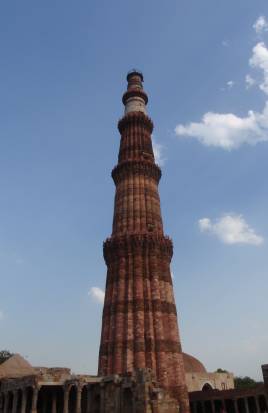
Qutb Minar in Delhi
Qutbuddin Aibak established the first of many Muslim dynasties in the late 12th century. He defaced an existing Hindu temple in Delhi then built the towering Qutb Minar amid the ruins. Three subsequent sultans added more structures, and in doing so, they created a new architectural style.
However, infighting weakened the Delhi Sultanate, and the last two Sultanate dynasties – the Sayyids and the Lodis – became vulnerable to attack.
Emperor Babur ruled from 1526 to 1530. He is credited with being a brilliant military campaigner, and it was his troops that won the battle at Panipat giving the Mughals rule over India.
Emperor Humayun was the son of Babur, and he ruled from 1530 to 1556. He was overthrown by Afgan chieftan, Sher Shah Sur, in 1540, but Humayun regained his throne in 1555.
Emperor Akbar was the son of Humayun, and he is considered the greatest Mughal ruler. He ruled from 1556 to 1605, and he left a substantial architectural legacy in the Agra area. He built the imposing red sandstone Agra Fort between 1565 and 1573. He also built the city of Fatehpur Sikri which was the Mughal capital for 14 years – from 1571 to 1585. Akbar consolidated and expanded the empire. He married a daughter of Raja Man Singh I of Amber, and this started a tradition of Mughal-Rajput alliances that brought peace and prosperity to the Mughal Empire.
Jahangir was the son of Akbar. He ruled from 1605 to 1627. He was not a brutal warrior but a learned politician. Jahangir had many wives, and his favorite, Jagat Gosain, gave birth to his successor, Shah Jahan. However, his Persian-born wife, Noor Jahan, is believed to have been the real power behind the throne.
Shah Jahan, the son of Jahangir, ruled from 1627 to 1658. Shah Jahan is best remembered for building the Taj Mahal in memory of his favorite wife, Mumtaz Mahal, whom died in 1631. Meanwhile, Shah Jahan built the Red Fort in 1639 and moved the Mughal capital to Delhi. Shah Jahan also built the Jami Masjid – India’s largest mosque – in Delhi in 1656. Quite an architectural legacy, indeed.
Emperor Aurangzeb was one of Shah Jahan’s sons, and he ruled from 1658 to 1707. Aurangzeb was a ruthless and bigoted ruler. He killed his brothers and imprisoned his father, Shah Jahan, in the Agra Fort until his death. Aurangzeb also alienated his Hindu subjects. He did, however, expand the Mughal Empire by adding territories to the south. However, by the time of Aurangzeb’s death, the empire’s economy was in ruins.
Another eight Mughal emperors ruled from 1707 to 1857, but the empire was in decline. Independent states formed, and numerous powers emerged – the Rajputs, nawabs, nizams, Wodeyars, Marathas, and Sikhs. India would not be under a central rule again until the British took power in 1857.
We visited many sites that were built during the seven centuries of Muslim rule. Some were simple, and some were spectacular. We will briefly describe those that are most memorable.
The Qutb Minar itself is a five story ‘Victory Tower’ started by Qutbuddin Aibak and completed by his successor, Iltutmish. The victory being memorialized in the tower was the establishment of the Delhi Sultanate in 1193 – the first Muslim kingdom in northern India. The tower is in the center of what became the Qutb Complex. Another of the structures built by Qutbuddin Aibak is the Auwwat-ul-Islam (Might of Islam) Mosque. This mosque was largely built from decorative panels salvaged from a preexisting Hindu temple. The faces of the Hindu gods and goddesses were chiseled off the panels before incorporating them in to the mosque. It is an unusual sight. Through the years, Islamic domes and arches were blended with decorative Hindu panels (sans faces) in other buildings in the complex, and a new form of architecture emerged.
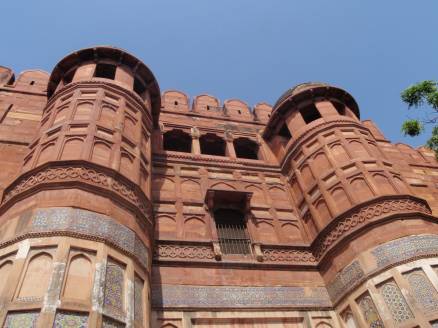
The Gate leading in to Agra Fort
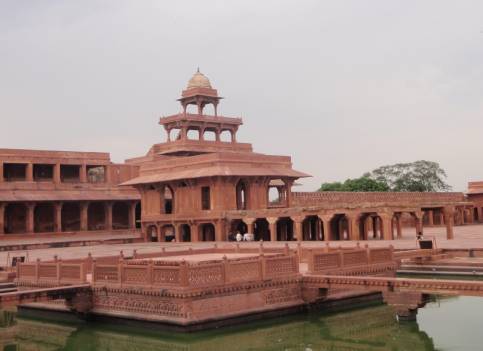
A pool in the courtyard at Fatepuhr Sikri
The Taj Mahal, also in Agra, was built between 1631 and 1643 by Shah Jalan in memory of his favorite wife, Mumtaz Mahal. Twenty thousand workers spent 12 years building this magnificent marble structure. It is a garden-tomb intended as an image of the Islamic garden of paradise. At the very center are the tombs of Shah Jalan and Mumtaz Mahal. The tomb chamber is surrounded by a filigree screen. Outside the screen is a circular area around which one can walk. This is made of white marble with detailed marble inlay, precious stone inlays, and gold. Outside, the 144 foot double dome is topped with a gold finial. There are four minarets in each corner, and two symmetric mosques to the sides (only one is an active mosque). The pool in front has lotus-shaped fountains and it reflects the tomb. All of this sits on beautifully manicured grounds.
Before going to see the Taj Mahal, we were told that most visitors find that it exceeds their expectations. Our expectations were quite high, so we did not expect it to be more than we expected. It was.
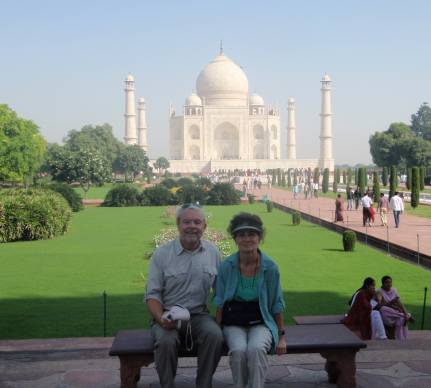
The Magnificent Taj Mahal
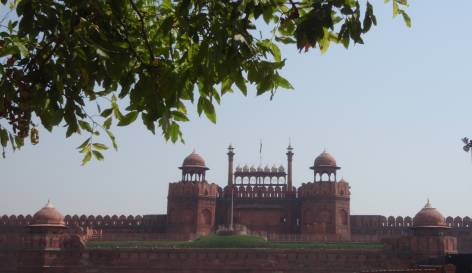
Red Fort in Delhi
The Jami Masjid in Delhi was also built by Shah Jalan from 1656 to 1662. It is India’s largest mosque, and it took 5,000 workers six years to construct. It has sandstone steps leading to the great arched entrances. Two minarets frame the central arch, and behind the arches are three black and white marble domes. Its central courtyard accommodates up to 20,000 people during Friday prayer sessions.
We also visited a few interesting mosques away from Agra and Delhi. We visited a very old mosque in Rajmahal (previously called Akbarnagar) that is also called Jami Masjid. This mosque, built in 1592, was built during Akbar’s reign. It was built by Raja Maan Singh whom was a Rajput general in Akbar’s army. And we visited the Katra Mosque, built by Aurangzeb’s governor in Murshidabad, Bengal. The governor, Nawab Murshid Quli Khan, built the Katra Mosque in 1724, and he is buried under its stairs. There remains a remarkable architectural legacy of the Islamic empires from the 12th through 19th century.
Follow us as we look at the British Empire or return to our land travel page.